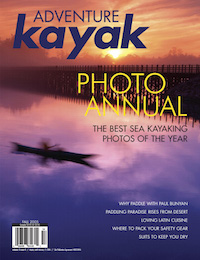While most of us agree that safety has more to do with judgment and skill than equipment, there may come a time when you will need to call on gear to get yourself out of a situation.
The coast guard requires all kayaks to have a minimum of safety gear including: a PFD, heaving line, bailer, whis- tle and flashlight (when paddling at night). Beyond this, the list of specialized and high-tech safety gear available to you grows every year.
Though the decision of where—on your body or boat— you carry any required or extra gear is not dictated by authorities, it’s a decision that can render the gear either useful or completely useless. A pump nestled in your back hatch won’t do you much good when your cockpit floods.
So, what extra safety gear should you carry and where is the best place to put it? Two leading kayakers share their thoughts.
Leon Sommé
My waist tow belt has been more practical and useful than any other item. With it, I can quickly pull somebody out of a dangerous situation like a riptide or rocks. After that my list would include spare paddles, a knife, a VHF radio and emergency tape to patch holes in a boat or paddling jacket.
I try to keep as much as possible on my body, so I have large pockets on my PFD. Hatches can quickly become flooded if they are opened in raging seas.
Whatever doesn’t fit on my PFD still has to be within an arm’s reach or it is no good in an emergency, so I keep the next most important items in my day hatch. Items include: extra clothes, chemical hand warmers, a jack- knife, a VHF radio, a flare bag, water, and a repair kit.
On my boat, I keep the decks mostly clear. Items can get washed away very quickly so I only keep a spare paddle, tow line, deck-mounted compass and my nau- tical chart.
An excellent training activity was to sit in my loaded boat on the beach. I assessed my set-up by seeing how easily I could solve common scenarios such as dealing with blisters, towing, and fixing a damaged boat from my cockpit.
Doug Alderson
If safety gear is not an integral part of my attire or my kayak it will likely get left behind. And if rescue gear is not on me or within very close reach it’s likely it will be unavailable during a distress. I learned this from paddling in rough seas and wanting to contact members of the group during a serious rescue and realizing my radio was in a hatch. Another time I got very cold sup- porting a seasick paddler. I had no immersion clothing within reach and my hands became unusable for pad- dling.
Fortunately, my foot pump and compass are part of my kayak and not removable. Beyond that, the specific gear I pack, and where I pack it, changes depending on what type of paddling I am doing. If I am teaching, I keep my towlines ready. In open water courses, I have my VHF radio turned on in a PFD pocket. I also carry extra clothes, first aid, food and water.
When touring with experienced senior paddlers, I keep very little gear on deck. I keep copies of my float plans and log books in the boat. If I am just out for the day, most of my gear stays at home. But I do always carry a small first aid kit and a bag of bivouac supplies, just in case.
Leon Sommé is a certified BCU 4 sea coach and ACA instructor. He has logged thousands of coastal kilometres on expeditions, including the successful 2003 circumnavigation of Iceland.
Doug Alderson has been a contributing member of the Canadian Recreational Canoe Association since the inception of the national sea kayaking program and is a CRCA senior instructor trainer.
 This article first appeared in the Fall 2005 issue of Adventure Kayak Magazine. For more great content, subscribe to Adventure Kayak’s print and digital editions here.
This article first appeared in the Fall 2005 issue of Adventure Kayak Magazine. For more great content, subscribe to Adventure Kayak’s print and digital editions here.



